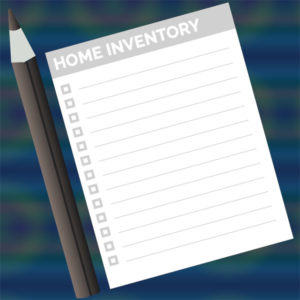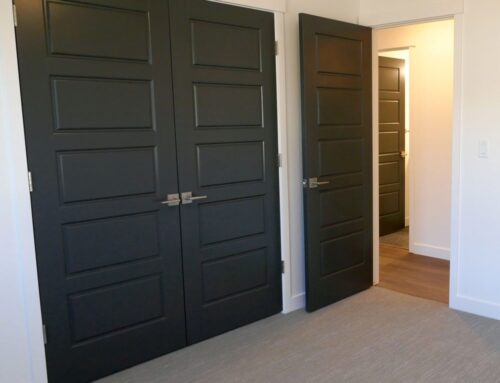 If you had a disaster happen at your home – fire, flood, theft, etc. – are you prepared to give your insurance company a detailed list of your belongings? We know this is definitely not a topic most people like to think about, but not planning ahead could cost you down the road. If a disaster occurs, you will need to be ready to provide a list of items and what they may be worth in order to get reimbursed. A disaster will be highly stressful, so relying on memory alone would be a challenge and will likely cost you in reimbursement amounts.
If you had a disaster happen at your home – fire, flood, theft, etc. – are you prepared to give your insurance company a detailed list of your belongings? We know this is definitely not a topic most people like to think about, but not planning ahead could cost you down the road. If a disaster occurs, you will need to be ready to provide a list of items and what they may be worth in order to get reimbursed. A disaster will be highly stressful, so relying on memory alone would be a challenge and will likely cost you in reimbursement amounts.
With the start of a new year, you may be looking to organize your life and home, so this is a great time to tackle the home inventory list.
Why Do I Need a Home Inventory List?
A home inventory list is helpful for a couple of reasons. First, it will help you get the right amount and type of insurance coverage. If you have higher-value items, you don’t want to have insurance coverage limits that won’t cover the cost of those items. There are also some items that may need special coverage. Your agent can help you with these coverages and make sure you have adequate coverage.
The second (and perhaps biggest) reason to have a home inventory is to help you file a claim if something unfortunate happens. You may recall the big items you have in your home – furniture, TVs, etc. – but could you remember all the small stuff? What’s in your jewelry box? What accessories do you have in each room? What do you have in the cabinets of your kitchen? You may think you could do a good job of figuring it out, but in the stress of that moment, there is a good chance you will forget things. A home inventory list helps ensure you get fairly compensated for any lost property. It will also likely speed up the process on getting compensated because you will be ready to go right away.
What Should a Home Inventory Include?
According to Forbes, a good home inventory includes the following information:
- A description of each item, including the make and model (if applicable)
- Estimated value of the item
- Purchase date
- Receipts (to prove ownership and price)
- Serial number
- A photo of each item
The more information you can include on your list and therefore provide to your insurance company, the better. However, your insurance understands you likely will not have receipts for every item in your home, and there are some general categories where you can provide a count. For example, you may not need to list every single piece of clothing you own and instead give a general count like 5 sweaters, 2 pairs of jeans, 10 dress shirts, and so forth.
How to Make Your Home Inventory
There is no right or wrong way to make a home inventory. Just make sure you have all the information your insurance company will need and it is formatted in a way that makes it easy for you to use in a stressful emergency situation. Having said that, here are some tips that may make the process easier for you:
- Make a List: Start by making a list of every item in your home and adding values, purchase price, etc. You can do this with pen and paper or a spreadsheet on your computer. You can organize your list however you want, but popular ways are organizing the list by room or by grouping like items together.
- Consider Using a Form or App: Many insurance companies have home inventory forms they can provide to you, and the Internet has a plethora of forms available for downloading and printing. There are also several home inventory apps, but these may have a cost associated with them. Some of the apps out there include the National Association of Insurance Commissioners app, Allstate Digital Locker, BluePlum Home Inventory, Encircle Home Inventory, Magic Home Inventory, Memento Database, My Stuff2 Pro, Nest Egg, Smart Inventory, and Sortly.
- Take Photos and/or Videos: As you walk through your home to compile your list, take photos and/or videos to supplement the list. It is also a good idea to take photos of labels that show make and model information and the serial number. If you don’t have a way to scan receipts, take a photo of those as well. Make sure the photo is close up and clearly shows the details of the receipt.
- Make Sure You Give Yourself Enough Time: Yes, going through your entire home is going to be time-consuming and likely will be a bit overwhelming. To help avoid getting really stressed out and wanting to give up, give yourself enough time to do the inventory. You may want to divide it up across several days or weekends to help avoid getting overwhelmed.
- Don’t Forget Off-Site Items: Belongings in a self-storage facility are most likely covered by your homeowners insurance. Make sure you inventory those and take photos of those items as well.
Where to Keep Your Home Inventory
You will want to store a copy of your inventory outside of your home so you have access to it if your home is destroyed or damaged to the point you cannot access it. A fireproof, waterproof home safe may keep the inventory intact during a disaster, but there is no guarantee. So, even if you plan on keeping the original in your home, plan on keeping a copy elsewhere. That copy could be an electronic version saved in the cloud (through an app or in a cloud-based file like Dropbox) or a physical copy kept at a family member’s home or in a safe deposit box.
How Often to Update Your Home Inventory
We all have good intentions of keeping up with things like this and updating them as we acquire new items and/or get rid of others, but sometimes life gets in the way. It’s a good idea to go over your inventory annually and make sure it is as up-to-date as possible. However, as you make major purchases during the year, hold onto receipts and make sure they are added to your inventory during your annual review. This annual review is also a good time to review your coverage and make sure you have adequate coverage in case the worst-case scenario comes true.
Looking for your dream home? Liberty Homes has been building new homes in Utah for nearly 30 years. We take pride in our trade, crafting each home as if it were our own. Our quality, affordable homes are energy smart and thoughtfully personalized for your active Utah lifestyle. We are currently building townhomes in Salt Lake County. Contact us today to get started building your new home.

Want home decorating and maintenance tips, craft ideas, recipes, and more delivered right to your inbox?
Sign up for our monthly newsletter:




